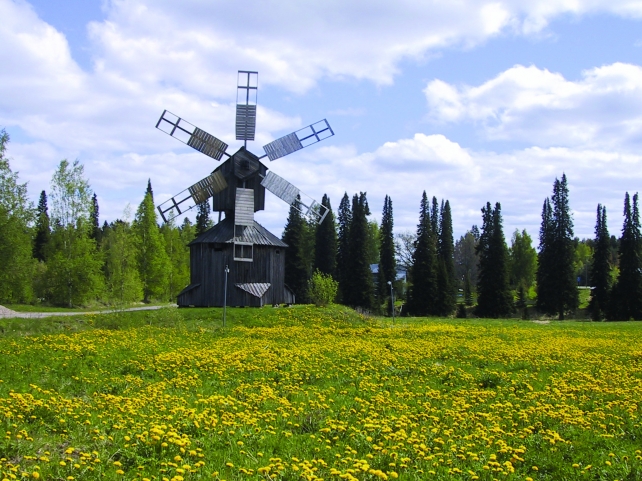
Virrat Heritage Village is a museum and travel destination for the whole family as well as a summer recreational area on Marttinen island, full of natural beauty. The Heritage Village is located in the immediate vicinity of Youth Centre Marttinen.
In Rajalahti House Museum and in Hali Loggers’ Cabin you can explore rural life in Virrat at the turn of the 19th and 20th centuries and the everyday life of loggers and forest work in the 1950s and 1960s. The Heritage Village also has many other old buildings, such as stables (1820s), a smock mill (1828), a smoke sauna (1840s) and a village storehouse (1878). In addition, there is a War veteran museum presenting 20th century war history and the Canal Museum maintained by the Transport Agency.
The museums in the Heritage Village are open for groups upon request around the year.
In the summertime, events and exhibitions are organised in the Heritage Village. The area has a café-restaurant, kiosk, handcraft, gift and art shops, a playground and Herraskoski canal.
You can book accommodation, restaurant, café and programme services from Youth Centre Marttinen, and you also have free use of the beach, guest boat dock, nature path and field fortification area from World War I.
The war historical past of Marttinen island begins in 1808–1809 during the Finnish War. In those days, there was a large depot in the terrain of Herraskoski between the Tampere maintenance centre and the major part of the Western army fighting in the Ostrobothnia area.
After the Lapua battle (14 July 1808), which was detrimental to Russian troops, lieutenant colonel Eek sent a guerrilla section to interfere with the Russians’ maintenance transportations. Flag-bearer Jaakko Juhana Roth was appointed as the guerrilla leader and sergeant major Kaarlo Juho Spoof as the deputy leader. The guerrilla section consisted of 41 men.
The section led by Roth arrived near Herranen on 18 July. They decided to give up on the plan to attack the Herranen depot, as the depot troops consisted of 200–300 men according to the scouts. The guerrilla section continued to Visuvesi on water, and two days later the section attacked an escort that was carrying a flour cargo and burned the Jarkko bridge.
The section continued their attacks in Ruhala and Kauttu (20 July), Teisko (21 July) and culminated in an attack in Mustalahti in Tampere (23 July). On the way to Tampere, Roth got the area’s peasants as well as troops retreating from Viapori as reinforcements, and the section increased to nearly 200 men.
The uncertainty among Russian troops increased due to the attack made in Mustalahti. Commandant Nyevnev in Tampere told his supervisors that their troops had been attacked by general Spuff via land and admiral Rutt via water. In addition, the guards in the Herranen depot decided to burn their storage and retreat to Alavus.
Roth’s operations in the area continued until the beginning of August. In the beginning of August, the Russians sent altogether 2,000 men to clean the Ruovesi area, and after the battles of 6-8 August, Roth’s section retreated to Kauhajoki.
Herraskoski became a proper battleground on 21 August 1808, when the Russians retreated to Virrat after losing the Alavus battle and set up their defence on the eastern shore of Herraskoski. The Herraskoski battle finished with the victory of the Swedish Finnish troops and the 2,100 Russian soldiers retreated to Ruovesi. When, at the same time, the Swedish Finnish troops had losses from the sides, the troops had to retreat towards Sweden. The Finnish War finished in 1809 on the Swedish side.
The restored base on the field fortification area was built during World War I. After the World War started, securing St. Petersburg, the Russian capital, was very important. Immediately after the war started, the Gulf of Finland was mined with such a tight minefield that there was little danger of the Germans landing.
The Gulf of Bothnia was left unguarded. Even though there were more than 40,000 Russian soldiers in Finland, they decided to start fortification work to protect St. Petersburg.
Field fortification works began in 1916. Several fortification chains were constructed. The outermost chain travelled the line Nurmes-Kuopio-Viitasaari-Ähtäri-Virrat-Tampere and Viapori, which was the main fortification of the chain.
There were not enough Russian engineering troops to execute the fortification works, and therefore the Russians started to recruit workers for barrier works. Recruiting volunteers was not difficult, as the fortification works paid a good salary.
However, in addition to volunteer workforce, municipalities were given forced labour duties in order to acquire additional workforce.
The work pace at the barrier worksite was lazy. And yet, you had to seem like you were working all the time. If you were caught not working, you would lose your salary for the day, which was four marks for a man and seven marks for a horseman. The builders developed an alarm system to warn of the Russian bosses. The alarm system made it possible to play cards or even to pick berries during the working day.
The barrier works ended unfinished when the March revolution started in Russia in 1917.
Virrat Heritage Village
Herrasentie 16
34800 Virrat
p. +358 (0)3 485 1900
perinnekyla@marttinen.fi
Accommodation, restaurant and programme services for groups upon request.
 Marttinen is one of the nine centres supported by the Finnish Ministry of Education and Culture.
Marttinen is one of the nine centres supported by the Finnish Ministry of Education and Culture.
Read more on the websites of Finnish Youth Centres Association